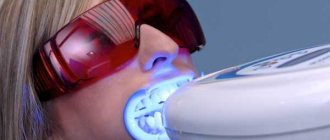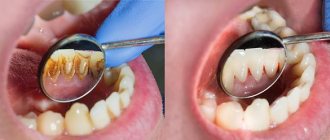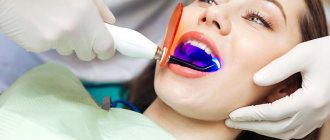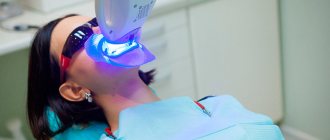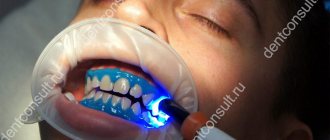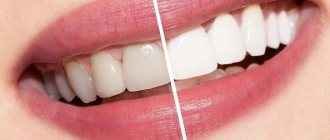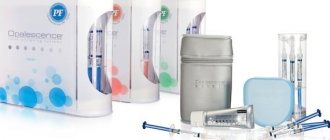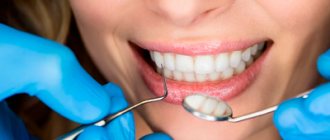Often, dental patients are offered a new method - lamp teeth whitening. Whitening is carried out with a LED lamp with cold light. Many people confuse this procedure with a procedure that uses an ordinary incandescent lamp, refusing to bleach using this method. Previously used lamps contributed to cracking of tooth enamel, spoiling it and causing a lot of unpleasant sensations. The impact of an LED lamp on tooth enamel occurs differently. What is this whitening method and how does it work?
Lamp teeth whitening - the essence of the method
It would be incorrect to say that teeth whitening with an LED lamp occurs due to the light it produces. In fact, light cannot affect tooth enamel. Its use is aimed at creating a chemical reaction between the reagent used and the pigments that are inside the enamel and color it.
The reagent is a special gel in the formula, which contains hydrogen peroxide in high concentration. Thanks to light exposure, a special form of oxygen with a highly active effect begins to form from it, which penetrates into the tooth tissue, oxidizing pigments. Thus, the light emanating from the lamp is a kind of catalyst, which stimulates the chemical process. The main advantage of this procedure is the low temperature of light waves. This allows the whitening procedure to be carried out painlessly for the patient and without harming the tooth enamel.
Where in Moscow can you lighten your teeth with cold light?
Aesthetic dentistry services, namely hardware procedures, can now be found in almost every clinic in Moscow. Before choosing a place, make sure of the professionalism of the specialists and the quality of the material used. Read reviews or consult your dentist.
At the A-Medic clinic, you can not only do light teeth whitening, but also take advantage of other aesthetic dentistry services. At the first appointment, the doctor will help you choose the appropriate lightening technique that will suit you in terms of cost and quality.
Carrying out the procedure
Teeth whitening with gel and lamp is an office procedure that should only be performed by a specialist with certain experience. Otherwise, in addition to an unsatisfactory result, the patient may suffer injuries to the oral mucosa. The procedure itself lasts about 1 hour, going through several stages.
- The preparatory stage is professional cleaning of the oral cavity. Existing plaque and tartar deposits are removed from the teeth. This procedure itself will help make the teeth lighter, and this will allow you to maximally select the tone of the tooth enamel that the patient wants to see in the end. The initial color is determined using a special VITA scale and if the result satisfies the patient, the dentist moves on to the next stage of whitening.
- The second stage begins with the implementation of oral safety measures. To ensure minimal contact with the teeth, cheeks and lips are isolated using a variety of napkins and films. To prevent the gums from coming under the aggressive influence of the whitening gel, and to avoid chemical burns on the soft tissues, they are coated with a protective composition. Most often, this composition is liquid rubber dam. After application, it quickly hardens, forming a protective film.
- The third stage is the whitening procedure. The surface of the teeth is pre-dried, and then it is evenly coated with active gel. After irradiating the teeth with an LED lamp for 10 minutes, this gel is removed. If the result does not satisfy the patient, the entire procedure is repeated again.
No more than three approaches can be performed during one visit to the dentist. All these steps will take about an hour. If this was not enough, a second visit to the dentist should only take place a week later.
How is it different from other methods?
There are many whitening methods: laser, home, Air Floor, Zoom, etc.
It can be very difficult to choose just one from such a variety of means. The patient is not always familiar with all the features and disadvantages of in-office lightening procedures. What makes the choice especially difficult is the emergence of more and more new methods, for example, light teeth whitening. It came to us from the USA quite recently, but has already earned recognition. How is it different from other professional techniques?
- The peroxide concentration in the Beyond system's brightening gel is 35-37% - this is more than that of the home system (10-15%), so the effect of cold light is much more noticeable and requires only 3 sessions of 10 minutes. Changing the color of enamel at home takes place in courses and takes more than a week.
- After using the Zoom technique, the patient may experience increased tooth sensitivity or unwanted tanning of the face due to harmful UV rays. The light from cold bleaching acts through filters; they neutralize dangerous radiation.
- Compared to the laser method, light technology is several times cheaper.
- Devices with ultraviolet lamps can often cause burns or damage the mucous membrane. To protect the patient, the dentist carefully covers the entire oral cavity with a special cloth. This makes the whitening process much more difficult. Halogen blue light lamp does not heat soft and hard periodontal tissues.
Efficiency of whitening with LED lamp
Teeth whitening with an LED lamp is a fairly effective method. In one visit to the dental office to whiten your teeth, you can lighten your tooth enamel by 6-10 shades. This is the case if the tooth enamel has turned yellow from exposure to food dyes or from smoking abuse. When tooth enamel has become gray, its lightening becomes possible only by a couple of tones. Minimal success in the procedure can also be observed in those patients whose enamel has changed color under the influence of tetracycline antibiotics, as well as if there is an excess of fluoride in the body.
Question! Is it possible to whiten teeth during pregnancy?
Speaking about the duration of the result, it depends on what natural shade of enamel the patient has, and to what extent the doctor’s further recommendations will be followed.
Options for solving the problem
There are two radically different approaches to teeth whitening: at-home and in-office whitening.
Clinical methods differ in that the procedure is carried out completely under the supervision of a physician. Also, more aggressive substances are used in the dentist's chair. These methods include:
- Whitening with a lamp;
- Using the Air Flow device;
- Bleaching using chemicals;
- Intracanal bleaching after endodontic treatment;
- Laser whitening technique.
You can whiten your teeth at home using toothpastes or whitening strips. But such methods cannot be called safe. It is not always possible to control the degree of whitening on your own. We also must not forget about the risk of increased tooth sensitivity, which may arise as a result of uncontrolled use of toothpastes or the use of folk remedies.
Causes of darkening of tooth enamel
In order for lamp teeth whitening to give the most positive results, you need to understand the reasons for the darkening of the enamel. In many cases, it will be enough to eliminate the negative impact factor so that the enamel acquires its natural shade.
The structure of dental tissue is quite porous. The enamel that covers the base of the tooth is translucent and cannot affect its overall color. The dark shade comes from dentin, which is visible through a thin layer of enamel. But why does it darken if the enamel itself is strong enough to allow negative factors to pass through? The reason lies in insufficient hygiene and love for solid food. Seeds, nuts, grilled candies, sour drinks and all similar products contribute to damage to the top layer of teeth, and then the dye easily penetrates into the tooth tissue, staining the dentin. The main factors contributing to the darkening of enamel:
- The most common reason is the consumption of products that contain a large concentrate of natural dyes. This could be: beets, blueberries or currants, cranberries or strawberries, coffee, strong tea, etc. In this case, careful hygiene will be the best way to get rid of the problem of darkening of teeth.
- The color of the enamel also changes in heavy smokers. The culprit in this case is the tar in the cigarette. As they settle on the surface of the tooth, they begin to gradually destroy tooth enamel. The best way out would be to give up cigarettes, but if the patient cannot do this, then it is worth paying more attention to hygiene procedures.
- The tooth may darken due to trauma during which the neurovascular bundle was damaged.
- The color also changes due to depulpation - when the nerve is removed from the tooth.
- Staining may occur due to the specific type of filling material used to seal the nerve canal.
- Progressive caries. At the initial stage of its development, this disease manifests itself only as small black dots, but if it is not cured in time, caries begins to progress, first destroying the enamel and then the dentin.
- Teeth may have congenital lesions, which are not classified as carious lesions. In addition to the dark color of the enamel, they differ in a different structure and shape.
- Excess fluoride in consumed water can provoke the development of a disease such as endemic fluorosis. When fluorosis begins to develop, dark areas, spots, or chalky streaks form on the teeth. All this leads to the destruction of enamel, and then dentin.
- Taking tetracycline antibiotics during pregnancy negatively affects the condition of the child’s teeth. The baby's teeth acquire a dark color during prenatal development.
The first two reasons for color changes are easily eliminated, but only in the first stages of development. In advanced situations, the whiteness of teeth cannot be restored. The problem is that the darkening becomes part of the healthy tooth and is now its natural shade.
LED lamp and its advantages
The main advantage of using LED lamps for teeth whitening is that there is no threat to the patient’s health. This method has passed all tests and is considered one of the safest. The rays that are reproduced by the lamp pass through a special filter, the task of which is to neutralize the harmful effects of infrared waves and ultraviolet radiation. Thus, the enamel surface is exposed to a temperature no higher than 37.6ºC. In addition, other advantages of this procedure can be noted:
- Short time for the whitening procedure.
- The ability to get the desired result the first time.
- The gel used contains components that help reduce sensitivity to the procedure.
- The effectiveness of the system makes it possible to eliminate defects such as age-related darkening and darkening caused by fluorosis.
The disadvantage of the teeth whitening procedure with an LED lamp can be considered the cost of the session, the price of which varies between 7,000 and 20,000 rubles and a large list of contraindications.
Indications for teeth whitening with an LED lamp and possible contraindications
Indications for use may include:
- uniform tooth pigmentation;
- darkened enamel, without whitish spots and dark stripes;
- in cases where the tooth does not need to be given a specific shape or size.
For contraindications, the list is longer:
- increased sensitivity;
- enamel with defects;
- It is not recommended to carry out bleaching during lactation or pregnancy (although no special studies have been conducted);
- special intolerance to hydrogen peroxide or other components that are part of the gel used;
- a large number of existing fillings, crowns or installation of fixed dentures;
- problems with the temporomandibular joint;
- limited age category of patients (under 16 years of age is not recommended);
- general diseases of patients: uncontrolled blood pressure, asthma, tumors, etc.;
- teeth that have damage such as chips, carious cavities, periodontitis, defects with fillings or crowns, etc.
The last point can be considered temporary. After eliminating the cause of the contraindication, teeth whitening with an LED lamp becomes acceptable.
The dentist may refuse the whitening procedure to a certain category of patients. As a rule, it includes those patients who neglect the doctor’s recommendations by not performing the prescribed procedures.
The largest number of teeth whitening procedures with an LED lamp includes 3 sessions. Each subsequent one can be completed only after a week. A positive result lasts 1–3 years. These terms depend on how well the patient adheres to the dentist’s recommendations and on the natural structure of the tooth. You can prepare your teeth for the whitening procedure by undergoing remineralization therapy. But the main rule that will help maintain a positive result for a long time is that after undergoing the procedure, do not eat foods with a large dye concentrate for a week.
Sources used:
- Therapeutic dentistry, E. V. Borovsky et al., Moscow., 1998
- Oral hygiene / Yu.A. Fedorov. — M.: Medicine
- The latest technologies in aesthetic dentistry / V.N. Chilikin. — M.: MEDpress-inform
How to save the result
Once you've gotten the whiteness you wanted, don't forget that your teeth now need more careful care. For a week, it is best to follow a clear (white) diet, the essence of which is to exclude coloring or very hot foods. It is also better to reduce your cigarette consumption.
In addition, professional products from the ASEPTA series for oral care will help you. They will prevent the appearance of yellow plaque, caries and other troubles, for example, ASEPTA Sensitive toothpaste will help reduce tooth sensitivity after the procedure. In the future, you can use ASEPTA PLUS Remineralization or Gentle Whitening toothpaste to maintain a snow-white and healthy smile.
Sources:
- Report on determining/confirming the preventive properties of toothpaste “ASEPTA PLUS” GENTLE WHITENING” Author: doctor-researcher A.A. Leontyev, head Department of Preventive Dentistry, Doctor of Medical Sciences, Professor S.B. Ulitovsky First St. Petersburg State Medical University named after. acad. I.P. Pavlova, Department of Preventive Dentistry
- Report on the determination/confirmation of the preventive properties of personal oral hygiene products “ASEPTA PLUS” Remineralization doctor-researcher A.A. Leontyev, head Department of Preventive Dentistry, Doctor of Medical Sciences, Professor S.B. Ulitovsky First St. Petersburg State Medical University named after. acad. I.P. Pavlova, Department of Preventive Dentistry
- Clinical studies of antisensitive toothpaste “Asepta Sensitive” (A.A. Leontyev, O.V. Kalinina, S.B. Ulitovsky) A.A. LEONTIEV, dentist O.V. KALININA, dentist S.B. ULITOVSKY, Doctor of Medical Sciences, Prof. Department of Therapeutic Dentistry, St. Petersburg State Medical University named after. acad. I.P. Pavlova
- Report on determining/confirming the preventive properties of toothpaste “ASEPTA PLUS” COFFEE and TOBACCO Author: doctor-researcher A.A. Leontyev, head Department of Preventive Dentistry, Doctor of Medical Sciences, Professor S.B. Ulitovsky. First St. Petersburg State Medical University named after. acad. I.P. Pavlova, Department of Preventive Dentistry
